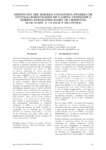Mostrar o rexistro simple do ítem
Obtención del modelo cinemático inverso de sistemas robotizados de cadena cinemática abierta empleando bases de Groebner: aplicación a un robot hexápodo
| dc.contributor.author | Guzmán Giménez, José | |
| dc.contributor.author | Valera, Ángel | |
| dc.contributor.author | Mata-Amela, Vicente | |
| dc.contributor.author | Díaz Rodríguez, Miguel Ángel | |
| dc.date.accessioned | 2019-08-13T11:41:08Z | |
| dc.date.issued | 2019 | |
| dc.identifier.citation | Guzmán Giménez, J., Valera, A., Mata-Amela, V., Díaz Rodríguez, M.A. (2019). Obtención del modelo cinemático inverso de sistemas robotizados de cadena cinemática abierta empleando bases de Groebner: aplicación a un robot hexápodo. En XL Jornadas de Automática: libro de actas, Ferrol, 4-6 de septiembre de 2019 (pp. 726-734). DOI capítulo: https://doi.org/10.17979/spudc.9788497497169.726. DOI libro: https://doi.org/10.17979/spudc.9788497497169 | es_ES |
| dc.identifier.isbn | 978-84-9749-716-9 | |
| dc.identifier.uri | http://hdl.handle.net/2183/23758 | |
| dc.description.abstract | [Resumen] Uno de los elementos más importantes del control de un sistema robotizado es su Modelo Cinemático Inverso (IKM), el cual calcula las referencias de posición y velocidad requeridas para que el robot siga una trayectoria predeterminada. Los métodos comúnmente empleados para obtener el IKM de sistemas robotizados de cadena cinemática abierta dependen fuertemente de la geometría del robot estudiado y no son procedimientos sistemáticos. Este trabajo presenta el desarrollo de un procedimiento de cálculo del IKM de robots de cadena cinemática abierta utilizando Bases de Groebner. El procedimiento propuesto no depende de la geometría del robot, ofreciendo una metodología sistemática para el cálculo del IKM. Las entradas del procedimiento desarrollado son los parámetros Denavit-Hartenberg del robot, y ofrece como salidas los códigos que constituyen el IKM calculado. Estos códigos pueden emplearse directamente en el sistema de control del robot o para simular su funcionamiento. El desempeño del procedimiento desarrollado se comprobó calculando el IKM de un robot hexápodo. El tiempo de cómputo del IKM calculado es comparable con el requerido por el modelo obtenido por métodos tradicionales, y el error de las referencias que ofrece como salida es absolutamente despreciable en todo el espacio de trabajo del hexápodo analizado. | es_ES |
| dc.description.abstract | [Abstract] One of the most important elements of the control system of a robotic system is its Inverse Kinematic Model (IKM), which calculates the position and velocity references required by the robot to follow a predetermined trajectory. The methods that are commonly used to obtain the IKM of open-chain robotic systems strongly depend on the geometry of the analyzed robot and they are not systematic procedures. This work presents the development of a procedure to calculate the IKM of open-chain robotic systems using Groebner Bases. The proposed procedure doesn't depend on the geometry of the studied robot, o ering a systematic methodology for the calculation of the IKM. The inputs of the developed procedure are the robot's Denavit-Hartenberg parameters, and it o ers as outputs the codes that constitute the calculated IKM. These codes can be used directly in the robot's control system or to simulate its behaviour. The performance of the developed procedure was proved calculating the IKM of a walking hexapod robot. The computation time of the calculated IKM is comparable to the time required by the kinematic model obtained by traditional methods, and the error of the computed references is absolutely negligible in all the hexapod's workspace. | es_ES |
| dc.description.sponsorship | Ministerio de Economía, Industria y Competitividad; FEDER-CICYT DPI2017-84201-R | es_ES |
| dc.language.iso | spa | es_ES |
| dc.publisher | Universidade da Coruña, Servizo de Publicacións | es_ES |
| dc.relation.uri | https://doi.org/10.17979/spudc.9788497497169.726 | es_ES |
| dc.rights | Atribución-NoComercial-CompartirIgual 4.0 | es_ES |
| dc.rights.uri | http://creativecommons.org/licenses/by-nc-sa/4.0 | * |
| dc.subject | Problema cinemático | es_ES |
| dc.subject | Modelo cinemático inverso | es_ES |
| dc.subject | Bases de Groebner | es_ES |
| dc.subject | Robot caminante hexápodo | es_ES |
| dc.subject | Kinematic problem | es_ES |
| dc.subject | Inverse kinematic model | es_ES |
| dc.subject | Groebner Bases | es_ES |
| dc.subject | Hexapod walking robot | es_ES |
| dc.title | Obtención del modelo cinemático inverso de sistemas robotizados de cadena cinemática abierta empleando bases de Groebner: aplicación a un robot hexápodo | es_ES |
| dc.title.alternative | Obtention of the Inverse Kinematic Model of Open-Chain Robotic Systems Using Groebner Bases: Aplication on an Hexapod Robot | es_ES |
| dc.type | info:eu-repo/semantics/conferenceObject | es_ES |
| dc.rights.access | info:eu-repo/semantics/embargoedAccess | es_ES |
| dc.date.embargoEndDate | 2019-08-25 | es_ES |
| dc.date.embargoLift | 2019-08-25 | |
| UDC.startPage | 726 | es_ES |
| UDC.endPage | 734 | es_ES |
| UDC.conferenceTitle | XL Jornadas de Automática | es_ES |






